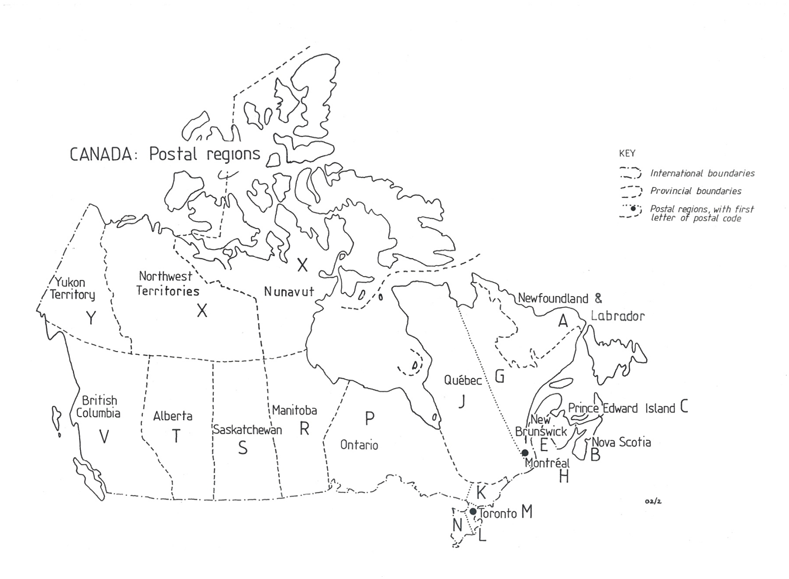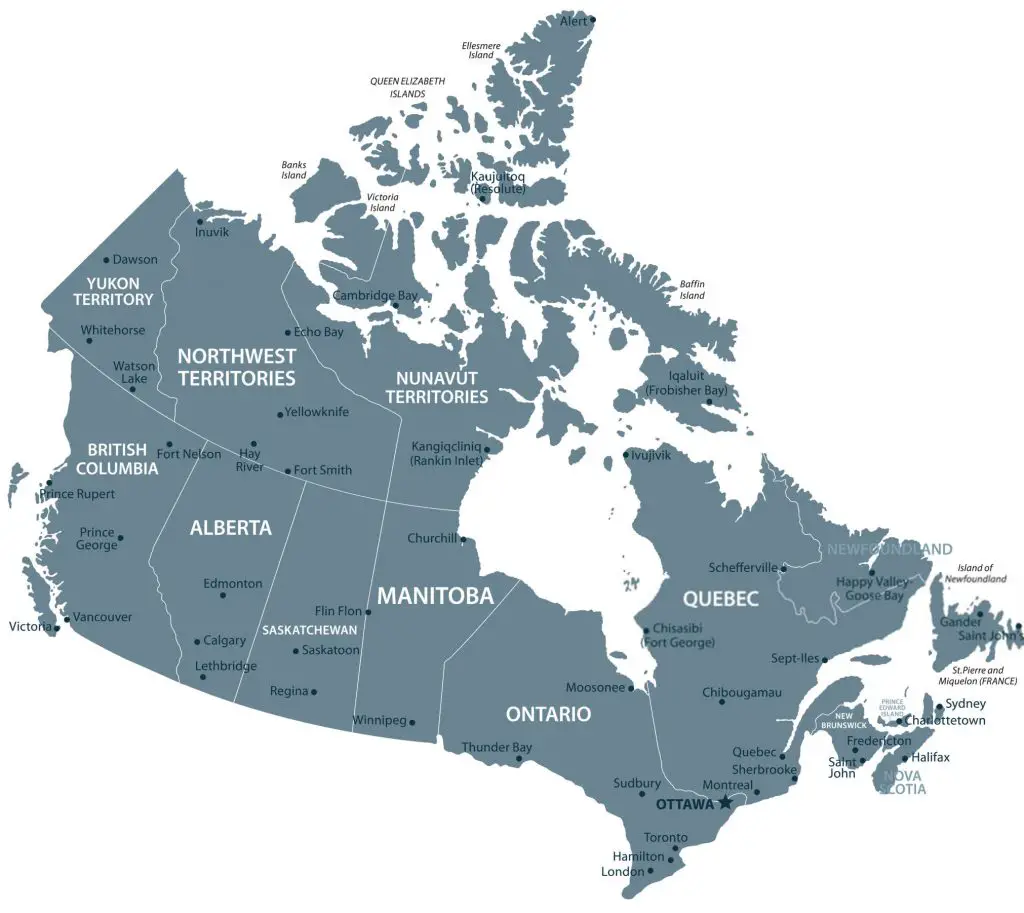A postal code is a series of letters or digits or both, sometimes including spaces or punctuation, included in a postal address for the purpose of sorting mail.
Canada Postal Code numbers consist of six digits, the first two digits represent one letter and those codes are assigned geographically. The last four digits are determined by the regional sorting facility (RSC).
Canada’s postal codes are alphanumeric, like Dutch, Irish, and British postcodes. Now Canadian postal codes are in the format A1A 1A1, where A is a letter and 1 is a digit, with a space separating the third and fourth characters.
Although postal codes are usually assigned to geographical areas, special codes are sometimes assigned to individual addresses or to institutions that receive large volumes of mail, such as government agencies and large commercial companies.
Universal Postal Union, the UPU was established in 1874 to build an international connection between countries through a unified postal service. The organization’s headquarters is located in Berne, Switzerland. The organization serves 192 member countries.
Many people call postal codes zip codes, and often people get confused about these two codes, so they ask: Is zip code and postal code the same? Or What is the difference between zip code and postal code?
The answer is;
These two codes are essentially the same in their purpose, but the term Zip code is mainly used in the USA; Postal Code is commonly used in other countries.
Here’s an explanation;
What is the ZIP code of Canada?
Zip is an abbreviation of the Zonal Improvement Plan. A zip code is a combination of numbers to form a specific identification code. The main aim is to enhance easy identification when delivering mail and packages.
Canadian Zip code is a six-character sequence that forms a portion of a postal address in Canada. Like British, Irish, and Dutch postcodes, Canada’s Zip codes are alphanumeric. They are in the format A1A 1A1, where A is a letter, and 1 is a digit, with a space departing the third and fourth characters.
The code helps to identify the location where mail and packages can be easily and accurately delivered. The main aim is to foster the exact delivery.
And……….,

What is the Canadian postal code?
The Canada Postal Code, or CPN as it is more commonly known, is the typographical representation of postal delivery post offices in Canada. It’s a six-character number that represents all the possible addresses that the letter carrier can deliver to.
Canadian postal codes use an alphanumerical format with six characters in the format “A1A 1A1” with the first character denoting the province of the address. The second character is a district within that province. The third character is a letter representing the “postal zone” of the province. The final three letters are numbers that indicate a smaller delivery area. Those numbers are used to sort and route mail and find addresses.
For example, a neighborhood called “St. Hubert” in Montreal would have a Postal code like STHUBT 1M1S.
The code was highly adopted to sort mail in bunch of large numbers of packages or letters. The system is used all over the world for easy identification of locations.
What is a Valid Canadian Postal Code Format?
Canadian postal codes are alphanumeric and composed of six characters strings.
A valid Canadian postcode has the following format –
- In the format A1A 1A1, where A is a letter and 1 is a digit.
- A space separates the third and fourth characters.
- Do not include the letters D, F, I, O, Q, or U. (The letters D, F, I, O, Q, and U never appear in a postal code because of their visual similarity to 0, E, 1, 0, 0, and V respectively)
- Letters W and Z also do not appear as the first letter of a postal code.

These six characters of Canadian postal codes represent a postal address in Canada.
Canadian Postal Abbreviations for Provinces and Territories

Postal abbreviations used to address and mail a letter in are called postal abbreviations or postcodes. Postal Abbreviations are two digit characters that help in sorting the letters and speed up the delivery process by sorting emails quickly.
When writing out the postal address for a location within Canada, the postal code follows the abbreviation for the province or territory.
A list of all Canadian province postal codes is given below. These postal abbreviations for Canadian Provinces are used for easy identification of the areas of Canada.
| Province or Territory | Postal Abbreviations | Capital |
| Alberta | AB | Edmonton |
| British Columbia | BC | Victoria |
| Manitoba | MB | Winnipeg |
| New Brunswick | NB | Fredericton |
| Newfoundland and Labrador | NL | St. John’s |
| Nova Scotia | NS | Halifax |
| Nunavut | NU | Iqaluit |
| Northwest Territories | NT | Yellowknife |
| Ontario | ON | Toronto |
| Prince Edward Island | PE | Charlottetown |
| Quebec | QC | Quebec City |
| Saskatchewan | SK | Regina |
| Yukon | YT | Whitehorse |
So now you’re looking for a full Canada ZIP code list, right? To help you, we collect a list of Canadian mailing addresses.
List of Postal Codes of Canada – All States Zip Code List

What is Canada’s postal code? Here are all provinces and territories of Canada postal code list
So, if you want to search the postal code of your area just here is a list that will help you to find the postal codes of Canada.
The following list contains the Postal Code ranges for Commercial Estimator has Local Multipliers in Canada. You can enter any Postal Code within a range.
For example, in the first range, you can enter A0A 0A0, A0B 6F2, or A0C 9Z9. If the Postal Code of the building is not in one of the ranges below, you can use one of the Province/Territory Symbols listed above.
Below you can find the Canadian Postal zip codes and their areas.
| Lower Postal Code | Upper Postal Code | Area of Local Multiplier |
| A0A 0A0 | A0C 9Z9 | Newfoundland Average |
| A0E 0A0 | A0E 9Z9 | Newfoundland Average |
| A0G 0A0 | A0H 9Z9 | Newfoundland Average |
| A0J 0A0 | A0N 9Z9 | Newfoundland Average |
| A0P 0A0 | A0P 9Z9 | Newfoundland Average |
| A0R 0A0 | A0R 9Z9 | Newfoundland Average |
| A1A 0A0 | A1G 9Z9 | St. Johns, NF |
| A1V 0A0 | A1V 9Z9 | Gander, NF |
| A2H 0A0 | A2H 9Z9 | Corner Brook, NF |
| B0A 0A0 | B0A 9Z9 | Cape Breton, NS |
| B0B 0A0 | B0W 9Z9 | New Brunswick Average |
| B1N 0A0 | B2A 9Z9 | Sydney, NS |
| B2H 0A0 | B2H 9Z9 | New Glasgow, NS |
| B2N 0A0 | B2N 9Z9 | Truro, NS |
| B2V 0A0 | B3B 9Z9 | Dartmouth, NS |
| B3H 0A0 | B3S 9Z9 | Halifax, NS |
| C0A 0A0 | C0B 9Z9 | Charlottetown, PE |
| C1A 0A0 | C1E 9Z9 | Charlottetown, PE |
| E1A 0A0 | E1G 9Z9 | Moncton, NB |
| E1N 0A0 | E1N 9Z9 | North Shore Area, NB |
| E2H 0A0 | E2P 9Z9 | St. John, NB |
| E2Y 0A0 | E2Y 9Z9 | Fredericton, NB |
| E3A 0A0 | E3C 9Z9 | Fredericton, NB |
| E3V 0A0 | E3V 9Z9 | Edmundston, NB |
| G0A 0A0 | G0C 9Z9 | Quebec Average |
| G0E 0C0 | G0E 9Z9 | Quebec Average |
| G0G 0A0 | G0H 9Z9 | Quebec Average |
| G0J 0A0 | G0N 9Z9 | Quebec Average |
| G0P 0A0 | G0P 9Z9 | Quebec Average |
| G0R 0A0 | G0T 9Z9 | Quebec Average |
| G0W 0B0 | G0Z 9Z9 | Quebec Average |
| G1A 0A0 | G2Z 9Z9 | Quebec City |
| G4R 0A0 | G4S 9Z9 | Sept Iles |
| G5L 0A0 | G5N 9Z9 | Rimouski |
| G7G 0A0 | G7K 9Z9 | Chicoutimi |
| G7S 0A0 | G8A 9Z9 | Jonquiere |
| G8Y 0A0 | G9C 9Z9 | Trois-Rivieres |
| H1A 0A0 | H4Z 9Z9 | Montreal |
| H7A 0A0 | H7Z 9Z9 | Laval |
| H9P 0A0 | H9S 9Z9 | Montreal |
| J0A 0A0 | J0C 9Z9 | Quebec Average |
| J0E 0A0 | J0E 9Z9 | Quebec Average |
| J0G 0A0 | J0H 9Z9 | Quebec Average |
| J0J 0A0 | J0N 9Z9 | Quebec Average |
| J0P 0B0 | J0P 9Z9 | Quebec Average |
| J0R 0A0 | J0T 9Z9 | Quebec Average |
| J0V 0A0 | J0Z 9Z9 | Quebec Average |
| J1E 0A0 | J1M 9Z9 | Sherbrooke |
| J2A 0A0 | J2E 9Z9 | Drummondville |
| J8X 0A0 | J9A 9Z9 | Hull |
| J9P 0A0 | J9P 9Z9 | Val d’Or |
| J9X 0A0 | J9X 9Z9 | Rouyn |
| K0A 0A0 | K0C 9Z9 | Ontario Average |
| K0E 0A0 | K0E 9Z9 | Ontario Average |
| K0G 0A0 | K0H 9Z9 | Ontario Average |
| K0J 0B0 | K0M 9Z9 | Ontario Average |
| K1A 0A0 | K4A 9Z9 | Ottawa |
| K6V 0A0 | K6V 9Z9 | Brockville |
| K7K 0A0 | K7P 9Z9 | Kingston |
| K8N 0A0 | K8R 9Z9 | Belleville |
| K8V 0A0 | K8V 9Z9 | Trenton |
| K9H 0A0 | K9L 9Z9 | Peterborough |
| K9V 0A0 | K9V 9Z9 | Lindsay |
| L0A 0A0 | L0C 9Z9 | Ontario Average |
| L0E 0A0 | L0E 9Z9 | Ontario Average |
| L0G 0A0 | L0H 9Z9 | Ontario Average |
| L0J 0A0 | L0N 9Z9 | Ontario Average |
| L0P 0B0 | L0S 9Z9 | Ontario Average |
| L1G 0A0 | L1R 9Z9 | Oshawa |
| L2E 0A0 | L2J 9Z9 | Niagara Falls |
| L2M 0A0 | L2W 9Z9 | St. Catharines |
| L3V 0A0 | L3V 9Z9 | Orillia |
| L4M 0A0 | L4N 9Z9 | Barrie |
| L6S 0A0 | L7A 9Z9 | Brampton |
| L8A 0A0 | L9K 9Z9 | Hamilton |
| M1A 0A0 | M9Z 9Z9 | Toronto |
| N0A 0C0 | N0C 9Z9 | Ontario Average |
| N0E 0A0 | N0E 9Z9 | Ontario Average |
| N0G 0A0 | N0H 9Z9 | Ontario Average |
| N0J 0A0 | N0M 9Z9 | Ontario Average |
| N0P 0A0 | N0P 9Z9 | Ontario Average |
| N0R 0A0 | N0R 9Z9 | Ontario Average |
| N1C 0A0 | N1L 9Z9 | Guelph |
| N1P 0A0 | N1T 9Z9 | Cambridge |
| N2A 0A0 | N2H 9Z9 | Kitchener |
| N2J 0A0 | N2L 9Z9 | Waterloo |
| N2M 0A0 | N2R 9Z9 | Kitchener |
| N2T 0A0 | N2V 9Z9 | Waterloo |
| N3C 0A0 | N3H 9Z9 | Cambridge |
| N3P 0A0 | N3V 9Z9 | Brantford |
| N4K 0A0 | N4K 9Z9 | Owen Sound |
| N5V 0A0 | N6Z 9Z9 | London |
| N7S 0A0 | N7X 9Z9 | Sarnia |
| N8N 0A0 | N9J 9Z9 | Windsor |
| P0A 0A0 | P0C 9Z9 | Ontario Average |
| P0E 0E0 | P0E 9Z9 | Ontario Average |
| P0G 0A0 | P0H 9Z9 | Ontario Average |
| P0J 0A0 | P0M 9Z9 | Ontario Average |
| P0P 0A0 | P0P 9Z9 | Ontario Average |
| P0R 0A0 | P0T 9Z9 | Ontario Average |
| P0V 0B0 | P0Y 9Z9 | Ontario Average |
| P1A 0A0 | P1C 9Z9 | North Bay |
| P3A 0A0 | P3G 9Z9 | Sudbury |
| P4N 0A0 | P4R 9Z9 | Timmins |
| P6A 0A0 | P6C 9Z9 | Sault Ste. Marie |
| P7A 0A0 | P7G 9Z9 | Thunder Bay |
| R0A 0B0 | R0C 9Z9 | Manitoba Average |
| R0E 0A0 | R0E 9Z9 | Manitoba Average |
| R0G 0A0 | R0H 9Z9 | Manitoba Average |
| R0J 0A0 | R0M 9Z9 | Manitoba Average |
| R2A 0A0 | R3Z 9Z9 | Winnipeg |
| R7A 0A0 | R7B 9Z9 | Brandon |
| R8N 0A0 | R8N 9Z9 | Thompson |
| S0A 0A0 | S0C 9Z9 | Saskatchewan Average |
| S0E 0A0 | S0E 9Z9 | Saskatchewan Average |
| S0G 0A0 | S0H 9Z9 | Saskatchewan Average |
| S0J 0A0 | S0N 9Z9 | Saskatchewan Average |
| S0P 0A0 | S0P 9Z9 | Saskatchewan Average |
| S4N 0A0 | S4Z 9Z9 | Regina |
| S6H 0A0 | S6K 9Z9 | Moose Jaw |
| S6V 0A0 | S6V 9Z9 | Prince Albert |
| S7H 0A0 | S7Z 9Z9 | Saskatoon |
| S9A 0A0 | S9A 9Z9 | North Battleford |
| T0A 0A0 | T0C 9Z9 | Alberta Average |
| T0E 0A0 | T0E 9Z9 | Alberta Average |
| T0G 0A0 | T0H 9Z9 | Alberta Average |
| T0J 0A0 | T0M 9Z9 | Alberta Average |
| T0P 0B0 | T0P 9Z9 | Alberta Average |
| T1A 0A0 | T1C 9Z9 | Medicine Hat |
| T1H 0A0 | T1K 9Z9 | Lethbridge |
| T1Y 0A0 | T3Z 9Z9 | Calgary |
| T4N 0A0 | T4R 9Z9 | Red Deer |
| T5A 0A0 | T6Z 9Z9 | Edmonton |
| T8V 0A0 | T8X 9Z9 | Grande Prairie |
| V0A 0A0 | V0B 9Z9 | Cranbrook |
| V0C 0A0 | V0C 9Z9 | Prince George |
| V0E 0A0 | V0G 9Z9 | Kamloops |
| V0H 0A0 | V0H 9Z9 | Penticton |
| V0K 0A0 | V0K 9Z9 | Kamloops |
| V0L 0A0 | V0L 9Z9 | Prince George |
| V0N 0A0 | V0N 9Z9 | Vancouver |
| V0P 0A0 | V0P 9Z9 | Port Alberni |
| V0R 0A0 | V0R 9Z9 | Prince George |
| V1C 0A0 | V1C 9Z9 | Cranbrook |
| V1L 0A0 | V1L 9Z9 | Nelson |
| V1R 0A0 | V1R 9Z9 | Trail |
| V1S 0A0 | V1S 9Z9 | Kamloops |
| V1V 0A0 | V1Z 9Z9 | Kelowna |
| V2A 0A0 | V2A 9Z9 | Penticton |
| V2B 0A0 | V2E 9Z9 | Kamloops |
| V2H 0A0 | V2H 9Z9 | Kamloops |
| V2K 0A0 | V2N 9Z9 | Prince George |
| V5A 0A0 | V7Z 9Z9 | Vancouver |
| V8J 0A0 | V8J 9Z9 | Prince Rupert |
| V8N 0A0 | V9E 9Z9 | Victoria |
| V9R 0A0 | V9V 9Z9 | Nanaimo |
| V9Y 0A0 | V9Y 9Z9 | Port Alberni |
| X0A 0A0 | X0C 9Z9 | Nunavut Average |
| X0D 0A0 | X0G 9Z9 | Northwest Territories Average |
| X1A 0A0 | X1A 9Z9 | Yellowknife |
| Y0A 0A0 | Y0B 9Z9 | Whitehorse |
| Y1A 0A0 | Y1A 9Z9 | Whitehorse |
Hope you found the post postal code in your area from this list. If you looking for Canada postal code database? Download our database of Canada postal codes in excel or CSV format.

FAQs
Now we are going to some frequently asked questions that people often ask.
What is the postal code number?
A postal code number is a delivery point that identifies the address location of a post office. It is unique and separated by region.
What is a 6 digit postal code?
The six-digit postal code consists of two parts: the last two digits (sector code) of the old four-digit postal code, followed by four new digits representing the delivery point within the sector.
What is a 5 digit zip code?
ZIP Codes are 5 – digit numbers developed by the United States Postal Service to represent individual post offices across the United States. A ZIP Code is just the name of the postal code system for the United States. Like the US, most countries have their own postal code system names.
How many active postal codes are there in Canada?
Estimates there are around 830,000 active postal codes in Canada.
What is the first postal code in Canada?
The Canadian postal code was first introduced in Ottawa, Canada’s capital, in 1971. For other significant milestones in the development of postal services in Canada, see The Chronology of Canadian Postal History (since 1506) from the Museum of Canadian History.
How do you write a Canadian postal code?
Postal codes in Canada are six digits long. They can be written either forward or backward. A valid Canadian postal code could look something like this: J8A 0C6 or J0A C9A.
How do I find a postal code?
Canada Post provides a free postal code look-up tool on its website, via its mobile application, and sells hard-copy directories and CD-ROMs. Many vendors also sell validation tools, which allow customers to properly match addresses and postal codes. Hard-copy directories can also be consulted in all post offices and some libraries.
Look up a Canadian postal code in any province or territory.
https://www.canadapost-postescanada.ca/info/mc/personal/postalcode/fpc.jsf
How do Canadian postal codes work?
Canada Post defines a postal code as follows: A six-character alphanumeric combination (ANA NAN) assigned to one or more postal addresses. The last three characters of the code are referred to as the Local Delivery Unit (LDU).
What is the zip code for Toronto, Canada?
The Toronto zip code is M5P 1N5. It is a kind of postal code used to arrange the physical location of an address, to facilitate the delivery of mail. It is also used as an identifier for specific businesses, establishments, and also geographical locations. And there is more than one zip code in Ontario province of Canada.
What is Ottawa’s zip code?
Ottawa, Ontario postal code is K1A 0A1. It is located in the center of Canada, in the province of Ontario. The capital consists of the eastern Ontario and western Quebec area, bordering on Gatineau city which is in the Quebec area.
What are Canada ZIP Codes Used For?
ZIP Code is a postal code. It is used to identify the location of a residence or business to enable the efficient delivery of mail. They are also known as “postal codes” and “ZIP+4 codes”.
ZIP Codes identify certain geographical regions and features, including counties, neighborhoods, apartment complexes, and post office boxes. Canada has different ZIP code rules from the United States.
In Canada, ZIP codes generally include four numbers but can have numbers and letters. ZIP Codes in the US are only made up of letters. Please note that if you write postal codes using just numbers, the first number should always be between 1 and 5.
For example, the Canadian border in Windsor, Ontario, has the Canadian ZIP code of L4X 0A8, while the ZIP code for the American side of the border is 48442. Canada also uses a single postal code system instead of the multiple code system used in the United States. A single system helps better streamline the mail service and makes it easier for postal workers to efficiently sort and deliver mail.
What is the type of postal code in Canada?
Canada Post has three types of postal codes:
– Letter-mail,
– Package handling, and
– Parcel handling.
The letter-mail system processes mail without having to go through a full street address. The parcel-handling system is for processing packages shipped across Canada, including packages from out of the country. The parcel-handling system falls under Canada Post and doesn’t require a registered street address.
Final Thoughts
Postal codes are a very important part of Canadians’ lives. Everything we receive in Canada should have a postal code on it – or attached to it (such as business cards). We often need to look up postal codes to send something to someone or ask them if they have a certain postal code.
Sometimes even non-Canadians need to find Canadian postal codes. That’s why our blog has gathered all. If you plan to send mail abroad then please keep the differences in ZIP codes in mind to ensure you write the correct address. Look through a full Canada postal codes list to find the one you need. Enjoy!


